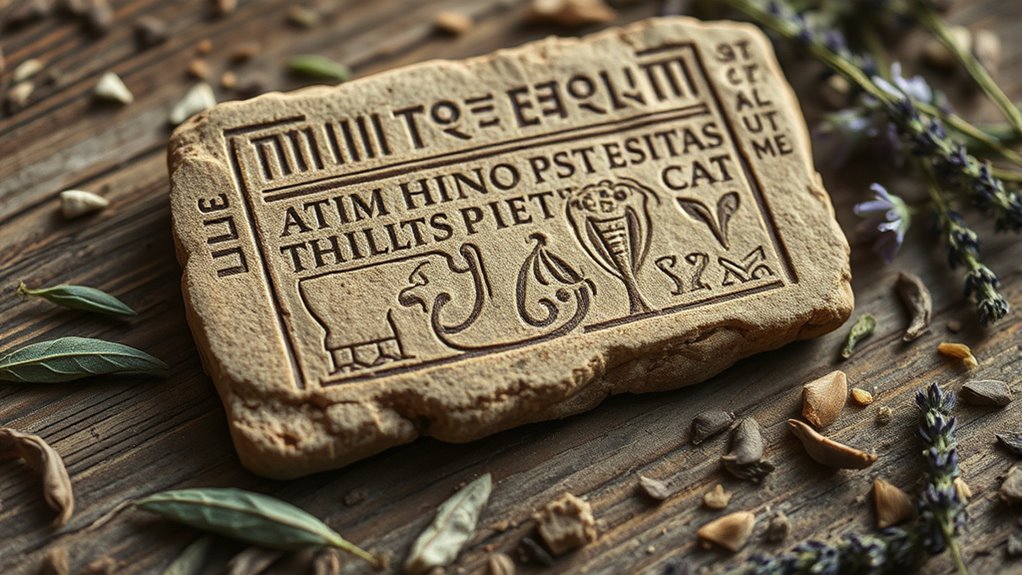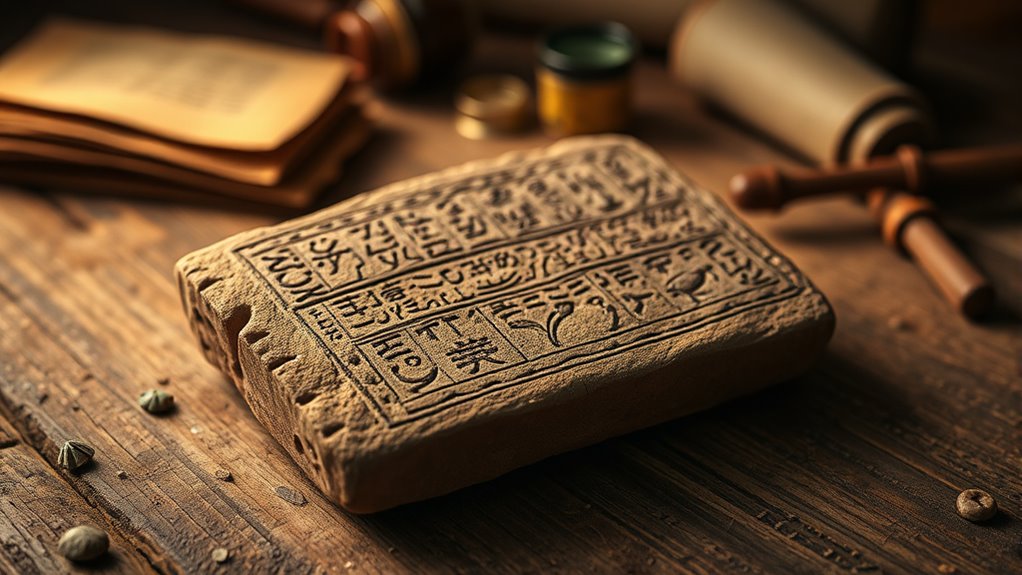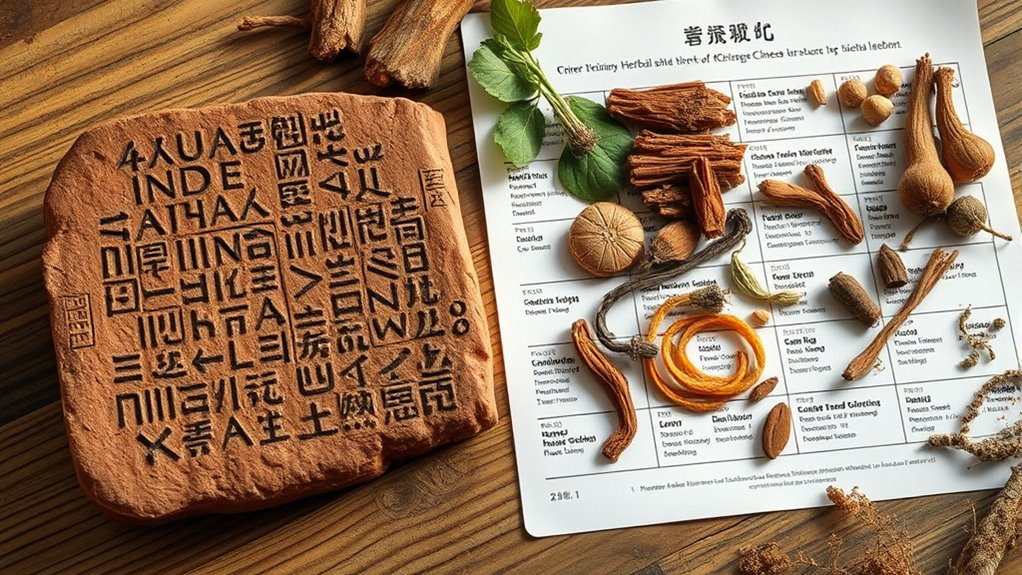Herbal medicine’s history begins with prehistoric humans who used plants for healing, and it’s recorded on Sumerian clay tablets as some of the earliest documented practices. Ancient civilizations expanded this knowledge through meticulous documentation and classification, including Ayurveda in India and Chinese herbal systems. Traditional Chinese Medicine (TCM) evolved over centuries, blending empirical and spiritual knowledge. If you want to uncover how this ancient wisdom still influences modern health approaches, keep exploring this fascinating journey.
Key Takeaways
- Early herbal medicine dates back to ancient civilizations like Sumeria, documented on clay tablets detailing plant-based remedies.
- Traditional practices involved oral transmission, spiritual symbolism, and herbal formulas for specific ailments.
- The development of herbal pharmacopoeias and classification systems standardized herbal knowledge across cultures.
- Chinese Medicine evolved over centuries, blending empirical observations with spiritual and holistic health principles.
- Modern research validates traditional herbal uses, integrating them into contemporary, holistic healthcare systems worldwide.
Early Beginnings: Herbal Knowledge in Prehistoric Cultures

Long before written records, prehistoric humans relied on plants for healing and survival. They discovered early remedies by observing nature and experimenting with local flora. These prehistoric remedies often involved simple herbal preparations, like poultices or infusions, passed orally from generation to generation. Over time, humans assigned herbal symbolism to plants, imbuing them with spiritual or mystical significance, which reinforced their use in healing rituals. This herbal symbolism helped shape early medicinal practices, as certain plants became associated with protection, essential, or spiritual connection. As a result, their knowledge of plants grew more sophisticated, laying the groundwork for future herbal medicine traditions. These early interactions with nature highlight humanity’s instinctive reliance on plants, creating a rich foundation for the development of herbal healing across ancient cultures. Additionally, early humans likely created herbal formulas to systematically utilize plants for specific ailments, further advancing their medicinal knowledge.
The Sumerian Tablets and the Dawn of Recorded Medicine

The Sumerian Tablets mark a pivotal moment in the history of herbal medicine, as they represent some of the earliest known written records of medicinal practices. These clay tablet inscriptions reveal Sumerian pharmacology, detailing plant-based remedies and treatments. By studying these inscriptions, you can understand how ancient healers documented their knowledge systematically. They highlight three key insights:
- The use of specific herbs for particular ailments
- The importance of precise measurements in herbal prescriptions
- The role of divine authority in legitimizing treatments
- The integration of music therapy to enhance healing practices and emotional well-being. Understanding how ancient practitioners combined herbal remedies with other healing modalities reflects the interdisciplinary approach early medicine embraced. This early recording system allowed for the transmission and preservation of medicinal knowledge across generations. It marks the dawn of recorded medicine, where herbal remedies evolved from oral tradition to written science, shaping future medical practices. Additionally, the recognition of standardized measurements was crucial in ensuring consistency and efficacy in herbal preparations. Furthermore, the development of pharmacological terminology helped standardize descriptions of remedies, facilitating clearer communication among practitioners and improving treatment outcomes. The creation of recordkeeping methods further contributed to the detailed documentation and dissemination of herbal knowledge throughout ancient civilizations.
Ancient Civilizations and the Expansion of Herbal Practices

As ancient civilizations expanded their understanding of herbal medicine, they built upon earlier knowledge to develop more sophisticated practices. They discovered new medicinal plants and incorporated them into their herbal rituals, which often held cultural or spiritual significance. Egyptian healers, for example, documented herbs like garlic and aloe, using them in complex treatments for various ailments. Similarly, in India, Ayurveda evolved with a focus on balancing bodily energies through herbal remedies. These civilizations recognized the importance of specific plants for healing and integrated them into rituals that reinforced their cultural identity. By refining these practices, they laid the groundwork for more systematic approaches to herbal medicine that would influence future generations across different regions. Additionally, the vertical storage solutions employed in some cultures facilitated the preservation and organized use of medicinal herbs, ensuring their availability for future use. Furthermore, the development of herbal pharmacopoeias helped standardize herbal prescriptions and enhance their efficacy. This progression reflects the increasing understanding of medicinal plant properties and their role in holistic healing methods. The continual refinement of techniques also contributed to the development of traditional healing knowledge, serving as a foundation for modern phytotherapy.
The Development of Traditional Chinese Medicine

Have you ever wondered how traditional Chinese medicine (TCM) developed into a complete system of healing? It evolved through centuries of herbal pharmacology, blending empirical knowledge with spiritual practices. Key steps include:
- Classifying herbs to understand their properties and uses. This process involves analyzing the herbal properties and how they influence the body’s balance. Additionally, the classification systems helped standardize herbal treatments across different regions and practitioners. Modern research continues to refine these classifications based on scientific analysis, improving the safety and efficacy of herbal remedies. Recognizing the importance of emotional well-being in holistic health, TCM also emphasizes balancing emotional states alongside physical health.
- Developing holistic healing techniques that balance body, mind, and spirit.
- Documenting herbal formulas in texts like the Huangdi Neijing, creating a foundation for future practices.
- The integration of AI safety measures has begun to influence modern herbal research, ensuring the reliability and safety of herbal medicine applications.
This progression allowed TCM to become more than just herbal remedies; it became a thoroughgoing approach to health. You now benefit from this rich tradition, where herbal pharmacology isn’t just about treating symptoms but fostering overall harmony. The development of TCM exemplifies how herbal medicine can serve as a pillar for holistic healing practices.
Herbal Medicine in the Modern World and Its Continuing Legacy

Herbal medicine continues to play a vital role in the modern world, blending ancient wisdom with contemporary science. You can see this in the rise of herbal supplements and plant-based therapies that emphasize plant efficacy. Researchers now study these remedies with rigorous scientific methods, validating traditional claims and uncovering new benefits. Modern applications include integrating herbal extracts into pharmaceuticals, developing herbal skincare, and promoting holistic health practices. Despite technological advances, the core principles of herbal medicine remain relevant, as many people seek natural, sustainable options for wellness. Additionally, the scientific validation of herbal remedies ensures their safety and efficacy in modern healthcare. The ongoing legacy of herbal medicine demonstrates its adaptability and enduring relevance, proving that age-old plant remedies still hold value in today’s health landscape. Furthermore, ongoing research into plant-based compounds continues to expand our understanding of their therapeutic potential, bridging traditional practices with modern medicine. Advances in holistic health practices also incorporate herbal medicine to support overall well-being and preventive care, highlighting the importance of integrative approaches in contemporary healthcare.
Frequently Asked Questions
How Did Herbal Medicine Influence Modern Pharmaceutical Development?
Herbal medicine greatly influences modern pharmaceutical development by inspiring herbal pharmacology and medicinal plant research. You leverage knowledge from traditional remedies to identify active compounds, develop new drugs, and improve treatment options. This ongoing research helps you discover plant-based medicines, ensuring safer, more effective therapies. As a result, herbal medicine‘s rich history continues shaping pharmaceuticals, bridging ancient wisdom with contemporary science.
What Are the Key Differences Between Ancient and Contemporary Herbal Preparation Methods?
They say “Old habits die hard,” and this applies to herbal preparation methods. Today, you use advanced herbal extraction techniques that guarantee consistency and potency, whereas ancient methods relied on simple boiling or grinding. Modern practices prioritize preparation safety standards, reducing risks of contamination. Unlike ancient times, you now have standardized processes, making herbal remedies safer and more effective, reflecting significant progress in how you prepare and consume herbal medicines.
Which Herbs From Ancient Texts Are Still Used in Modern Treatments?
You’ll find that herbs like ginseng, ginger, and garlic from ancient texts are still used today. Ancient herb identification helps you connect traditional remedies with modern herbal sourcing, ensuring authenticity and effectiveness. These herbs continue to play a crucial role in contemporary treatments, thanks to their proven benefits. By understanding their historical roots, you can appreciate their ongoing relevance in maintaining health and wellness.
How Did Cultural Exchange Shape Herbal Practices Across Civilizations?
Cultural diffusion and herbal trade greatly shaped herbal practices across civilizations. You see, as societies interacted through trade routes like the Silk Road, they exchanged herbs, knowledge, and remedies, blending traditions. This herbal trade introduced new plants and healing techniques, enriching local practices. Consequently, diverse cultures adopted and adapted herbs from each other, creating a rich, interconnected herbal medicine legacy that still influences modern treatments today.
What Are the Challenges in Preserving Traditional Herbal Knowledge Today?
You face challenges in preserving traditional herbal knowledge today, especially as only 25% of indigenous plant remedies are documented. Intellectual property laws can hinder knowledge transmission, risking loss of valuable practices. Modernization and globalization threaten cultural authenticity, causing knowledge to fade. To protect this heritage, you need to support documentation efforts and respect indigenous rights, ensuring that traditional wisdom remains accessible and continues to benefit future generations.
Conclusion
You’ve seen how herbal medicine evolved from prehistoric roots to a sophisticated practice today. Did you know that over 80% of the world’s population still relies on herbal remedies for primary healthcare? This rich history shows how ancient knowledge continues to influence modern medicine. Embracing this legacy, you can appreciate the enduring power of herbs and their essential role in health and healing across centuries.










